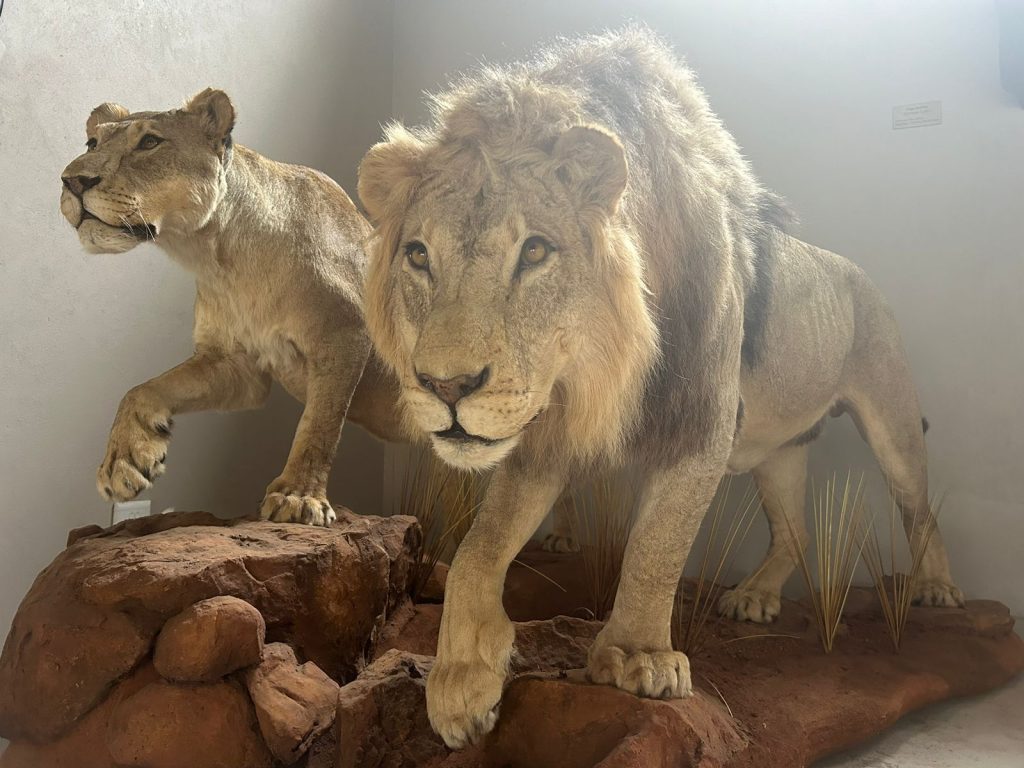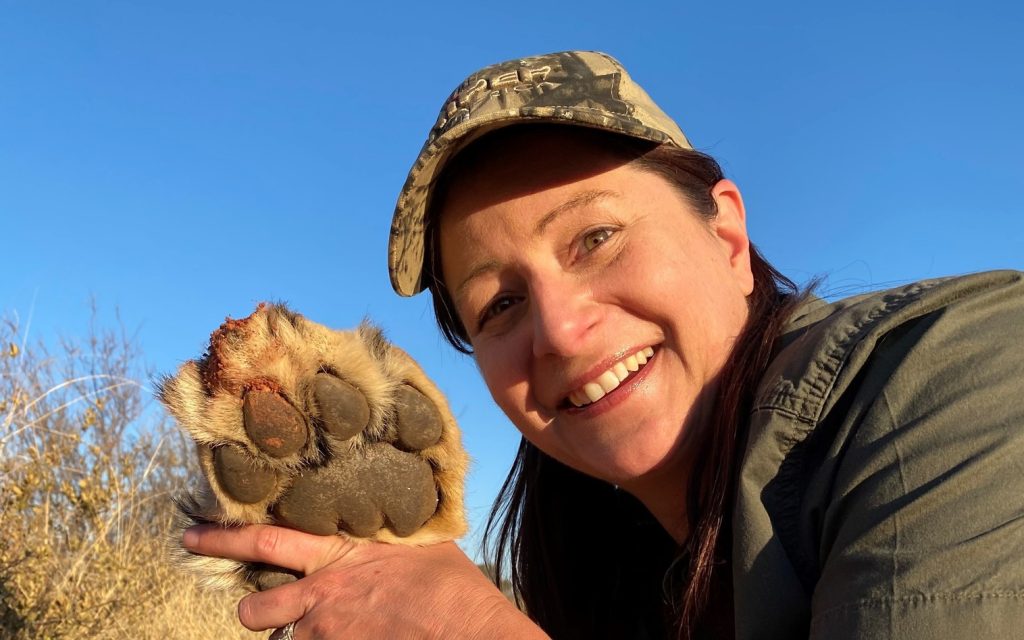I was given a lioness for my birthday! Yes, a lioness. I must admit that back then, I was more scared than excited.
I had had my fair share of hunting adventures with African plains game but never any of the Big 5 nor Dangerous 7 – and I was conflicted. My husband’s unwavering belief in me and his belief in my hunting skills are what changed my mind and started my dream lion hunt.

The hunt was on for one of Africa’s most iconic and dangerous predators, and the preparations began in earnest. I knew we would have to do some walking (not quite as much as training for an elephant hunt), but some physical training would be essential, so I started doing 3-mile walks every second day and some light weights in between.
Lions (and lionesses) are part of the big five African game animals (the other four are leopard, rhino, African Bush Elephant, and Cape Buffalo). They are also part of the Dangerous 7 namely, the Big 5, plus the Nile Crocodile and hippopotamus.
Out of interest, the Dangerous 7 is distinctly different from the Big Seven in that the Big Seven includes two ocean giants (the southern right whale and the great white shark), neither of which are legally huntable in South Africa.
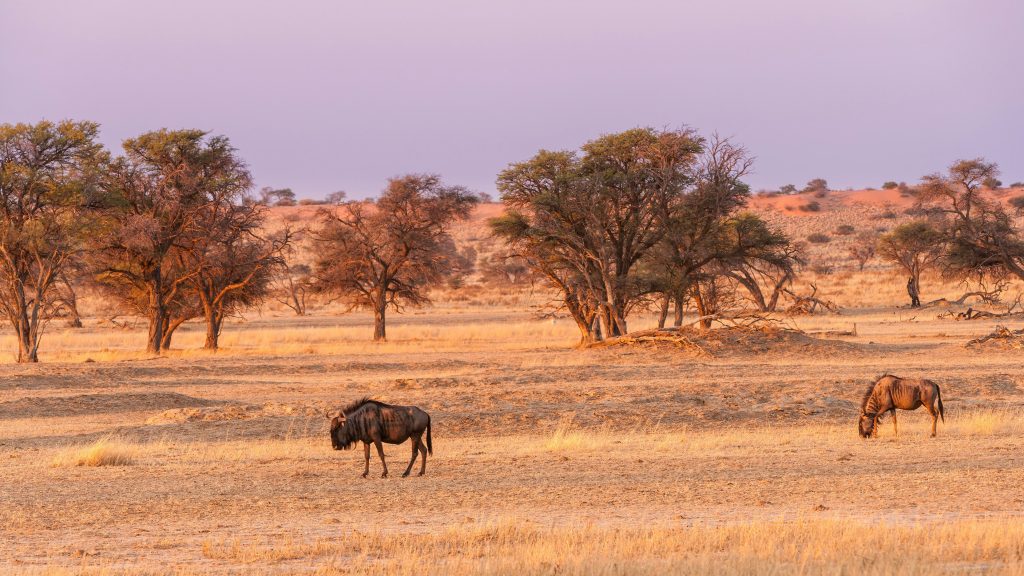
The Kalahari Desert is a destination of captivating beauty with its vast, sweeping landscapes and golden dunes that stretch endlessly. The play of light and shadow across these dunes creates a mesmerizing, ever-changing panorama.
The region’s sparse vegetation is adapted to the arid conditions and offers a unique beauty with resilient, twisted trees and vibrant bursts of color during the brief rainy season. The Kalahari night sky is a celestial masterpiece, free from light pollution, revealing a dazzling array of stars. This desert’s allure lies in its stark, yet enchanting, simplicity and its ability to inspire a sense of wonder in those who venture into its heart. And this was the spellbinding scene for the start of my lion hunting adventure.
After a long drive to the Northern Cape region of South Africa, we arrived at our destination in the Kalahari and were warmly welcomed. Our room was beautiful, as was the air conditioning that we turned onto max, as the heat in the desert could be overwhelming at times! We wasted no time and immediately set out to scout the area for lions.
The lion hunting safari gets underway!
When on a hunting safari, the experienced trackers sit on the front of the pickup truck to keep a lookout for any spoor. They are exceptionally good at what they do, and it wasn’t long before they pinpointed some spoor. Seeing the huge track, I realized that this was not a dress rehearsal, and I knew that I was up against something massive and powerful…something that could take you out in a second if you didn’t keep your wits about you. It was scary, yet filled me with intense excitement to start a battle with this fearsome creature!
The tracks were female, so the hunt was on! Our hunting party got out, and we settled into formation and started on foot. The hunting party consisted of the primary PH, 2 trackers, myself, and my son Keenan (also a PH), with the 458 backup. My PH was hunting with a 500 Jeffrey, and I had the faithful 375. Typically, bolt-action rifles chambered in larger calibers are recommended for hunting large and dangerous game such as lions.
What can I use to hunt large and dangerous game?
Some commonly used calibers to hunt large and dangerous game animals include:
- .375 H&H Magnum: This caliber is known for its excellent stopping power and is considered the minimum for hunting dangerous animals in Africa.
- .416 Rigby: A powerful caliber suitable for taking down large animals.
- .458 Lott: A heavy-hitting round with significant stopping power.
- .470 Nitro Express: Another potent caliber for hunting dangerous game.
- .500 Nitro Express: Extremely powerful and often used for the largest and most dangerous game, such as us now, by participating in a lion hunting safari.
Use premium, heavy, expanding bullets to ensure a clean and ethical kill. On a lion hunting safari, hunters must have the skills and experience, while prioritizing the animal’s well-being and local conservation laws. Consultations with local authorities and professional guides, in addition to respecting ethical hunting principles, are paramount when hunting lions in Africa.
It was incredibly hot, and we finally found the lion standing in the shade under a tree. We used the opportunity to set up on the sticks and started getting into position to take a shot. As l placed my rifle on the sticks, I could feel the adrenaline pumping through my body, and in all the excitement, I unfortunately pulled the shot.
It was an amateur’s mistake, but nerves got in the way! Instead of hitting or missing the target, I ended up just slightly nicking the side of her neck, enough to draw a little blood but not enough to penetrate the skin. Let’s just say enough to annoy her – a lot!
When a lion is wounded, the first step is to assess the nature of the injury, as the type and location of the wound will influence the tracking strategy. A wounded lion can leave behind signs, such as blood trails, tracks, and disturbed vegetation, that trackers know how to read. The most critical sign is the blood trail left by the wounded animal.
Trackers will carefully examine the blood to determine the severity of the injury. The blood’s color, quantity, and consistency explain the lion’s condition. In essence, my poor shooting just ended up being a few drops of blood and annoyed her. She simply bolted and ran away. Thank goodness I had an experienced PH, who calmly told me we would now have to follow and track her down.
How does a tracker track a wounded lion while on a hunting safari?
- Tracking a wounded lion is a challenging and potentially dangerous task that requires specialized knowledge and skills. Experienced trackers use various signs and techniques to follow the wounded animal’s trail while ensuring the safety of the hunting party.
- They will examine the lion’s tracks to confirm the animal’s direction of travel. Lion tracks can be distinguished from other big cat tracks by their size and unique features. They will note the size, depth, and distance between tracks to estimate the lion’s pace. As the lion moves through the environment, it may disturb vegetation like grass, leaves, or branches. Experienced trackers will look for signs of vegetation disturbance, which can help them confirm its path and direction.
- The presence of lion scat or urine can also be a sign. Trackers may examine the freshness and frequency of these signs to gauge the lion’s progress.
- Observing the behavior of other animals in the area can be telling, for example, vultures circling overhead, hyenas, or scavengers congregating in a specific area, or the alarm calls of birds and other wildlife can indicate the presence of a wounded lion.
• Trackers take into account their behavior in the terrain and habitat. When wounded, the lion will often seek cover, such as thickets or rocky outcrops, and knowledge of lion behavior in different environments is crucial for tracking.
Effective communication within the tracking team is essential, and they will share information about its movements and coordinate their efforts to follow the trail. Tracking a wounded lion requires patience and caution. Trackers must be prepared for unexpected encounters and be vigilant for the possibility of the wounded lion charging in self-defence. Safety remains paramount, and PHs will be armed and prepared. The tracking process may take hours or even days. Trackers will continuously follow the signs, reassess the lion’s condition, and adjust their approach as needed. It is a delicate and demanding task requiring specialized knowledge, experience, and respect for the animal and its environment.
We had phenomenal trackers, and we started after the wounded lioness on foot for over 2 ½ hours. The trackers were incredible, they kept on her trail even when she was no longer visible. Walking through this vegetation can be challenging due to the thorny and rugged terrain. One of the reasons I was happy to have done a little weight training in preparation for hunting lions in Africa was that carrying that rifle for so long gets extremely tiring. Let me tell you that the rifle got seriously heavy after about the first hour, and my arms were sore and stiff for days afterward!
Over the 2 ½ hours as we stalked the lioness, we caught sight of her a few times, but never more than a glimpse, as these animals are highly skilled and opportunistic hunters, and stalking is a critical part of their hunting behavior. At this point, I’m not sure who was doing the active stalking. I think that at one point, we were stalking each other!
Stalking requires patience. Lionesses may spend hours silently inching closer to their prey. They carefully observe the behavior of their target, waiting for the right moment to strike. Imagine that… being stalked by a lioness!!! Lionesses are known for their stealth and ability to remain concealed. They approach their prey carefully, using available cover like tall grass or shrubs to hide their presence. Their fur coloration helps them blend into their surroundings and makes a hunt all the more challenging.
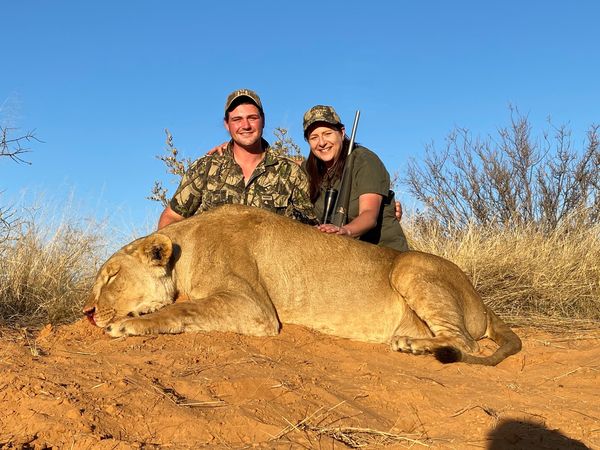
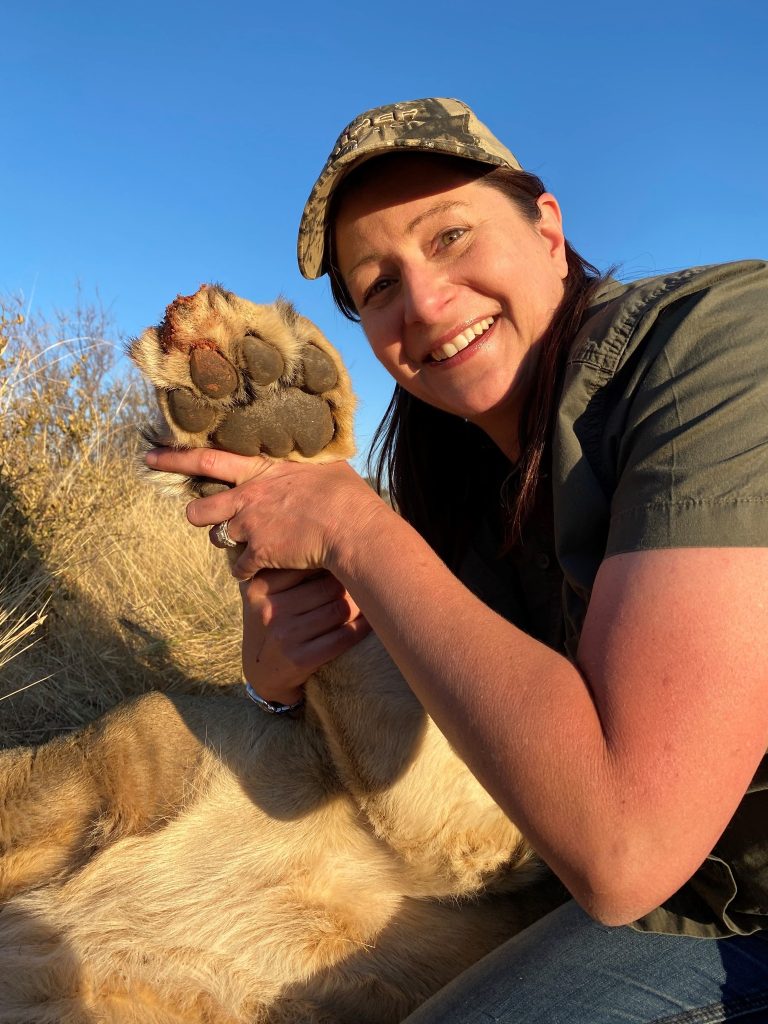
Eventually, we came upon her underneath a thorn tree, completely camouflaged, watching us. We circled, got into a good shooting position, and out came the sticks for the second time. I balanced the rifle neatly and took a couple of deep breaths to ensure I had calmed my nerves. I found her in the scope, took a deep breath in, exhaled, and gently squeezed the trigger. A perfect shot straight through the heart, and she went down right there. A good and quick kill. A little timeout to say our thanks for this magnificent creature and then time to celebrate.
I felt extremely proud of myself, I had worked hard for my lioness. She had not made it easy, but she was the best birthday present and a game hunting experience I will remember until the day I die.

Hunting lions in Africa
The opportunity to participate in a big game or dangerous game hunting safari in South Africa is a sought-after experience that many hunters dream of. Hunting lions in Africa is the cherry on top of that dream and the pinnacle of exhilarating hunting adventures and experiences.
